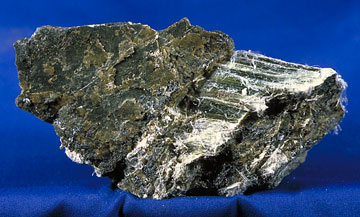serpentine

Serpentine. Credit: Mineral Information Institute.

Chrysotile. Image: Mineral Information Institute.
Serpentine is a common hydrated magnesium silicate mineral, (3MgO.2SiO2.2H2O), whose structure resembles that of kaolinite. Serpentine is a secondary mineral, formed from minerals such as olivine and orthopyroxene, and occurs in igneous rocks containing these minerals. There are three varieties: chrysotile (which is fibrous and the chief form of asbestos), antigorite, and lizardite. It has monoclinic system crystals.
Serpentine comes in various colors, usually green, although sometimes brownish gray, or yellow, with a pattern of green mottling. Having an attractive texture and being easily polished, it is used as an ornamental stone. Hardness 2.5–4; relative density 2.5–2.6.
Chrysotile
Chrysotile is a fibrous serpentine mineral, from which comes most of the world's supply of asbestos. It has crystalline tubular fibers that are particularly suitable for spinning and weaving heat-resistant fabrics.


